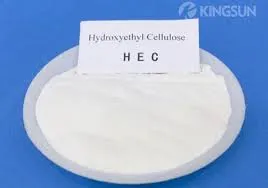
دېكابىر . 02, 2024 04:18 Back to list
how is hydroxyethyl cellulose made
How is Hydroxyethyl Cellulose Made?
Hydroxyethyl cellulose (HEC) is a non-ionic, water-soluble polymer derived from cellulose, a natural polymer that forms the structural component of plant cell walls. Its unique properties make it a crucial ingredient in a variety of applications, including pharmaceuticals, cosmetics, food products, and construction materials. The production of hydroxyethyl cellulose involves several key steps, including the preparation of cellulose, etherification, and purification.
Step 1 Preparation of Cellulose
The first step in the production of hydroxyethyl cellulose is obtaining high-quality cellulose, typically derived from wood pulp or cotton linters. Cellulose is a linear polysaccharide composed of glucose units linked by β-1,4-glycosidic bonds. The cellulose source is subjected to a series of treatments to remove lignin, hemicellulose, and other impurities, yielding a purified cellulose material. This purification often involves bleaching and chemical treatments using sodium hydroxide or sulfuric acid to achieve the desired cellulose purity.
Step 2 Etherification Process
Once purified cellulose is obtained, the next step is etherification, which is the key chemical reaction in the production of hydroxyethyl cellulose. In this process, the purified cellulose is reacted with ethylene oxide, a cyclic ether, in the presence of a catalyst. The reaction typically occurs in an alkaline medium, which helps to activate the hydroxyl groups (-OH) on the cellulose molecule.
During etherification, ethylene oxide molecules are introduced to the cellulose chains, creating hydroxyethyl (HE) groups and forming a new polymer structure. The degree of substitution (DS), which indicates the average number of hydroxyethyl groups substituting the hydroxyl groups on the cellulose, can be controlled by adjusting reaction conditions, such as temperature, pressure, and the concentration of reagents. Generally, a higher DS results in increased water solubility and improved thickening properties.
Step 3 Neutralization and Purification
how is hydroxyethyl cellulose made

After the etherification reaction, the mixture is neutralized to stop the chemical reaction, typically by adding an acidic solution. This step helps ensure the stability of the resulting hydroxyethyl cellulose. Following neutralization, the product is subjected to a series of purification steps, which may include washing, filtration, and precipitation. The aim of this purification is to remove any unreacted ethylene oxide, catalyst residues, and by-products that may have formed during the reaction.
The most common purification method involves dissolving the hydroxyethyl cellulose in water and then precipitating it using an organic solvent, such as ethanol or isopropanol. This process allows for the selective separation of the desired polymer based on its solubility characteristics.
Step 4 Drying and Milling
Once the hydroxyethyl cellulose is purified, it may be in a viscous liquid form or as a wet solid. The next step involves drying the product to remove excess solvent and achieve the desired moisture content. This can be done using various drying techniques, such as air drying, freeze drying, or spray drying.
After drying, the hydroxyethyl cellulose is often milled to achieve a consistent particle size, which is crucial for its performance in different applications. The final product is typically available as a white or off-white powder, which is highly soluble in water and can form a clear, viscous solution.
Applications of Hydroxyethyl Cellulose
Hydroxyethyl cellulose has a wide range of applications due to its unique properties. In the pharmaceutical industry, it is commonly used as a thickening agent, binder, and stabilizer in various formulations. In cosmetics, HEC is valued for its ability to enhance the texture and stability of products such as lotions and creams. Furthermore, in the construction industry, it serves as a thickener and water retention agent in cement-based materials.
In summary, the production of hydroxyethyl cellulose involves multiple steps, from sourcing and purifying cellulose to its etherification and purification. The flexibility and adaptability of HEC make it a vital component across various industries, contributing to the formulation of high-quality products that meet consumer needs.
-
Unlocking the Benefits of HPMC Products: A Gateway to Versatile Applications
NewsAug.07,2025
-
Unleashing the Potential of HPMC Ashland: A Comprehensive Look
NewsAug.07,2025
-
Tile Bonding Cellulose: The Key to Superior Adhesion and Durability
NewsAug.07,2025
-
Hydroxypropyl Methylcellulose Powder: The Versatile Component in Modern Pharmaceuticals
NewsAug.07,2025
-
Hydroxyethyl Cellulose: The Versatile Solution for Various Industries
NewsAug.07,2025
-
Hydroxyethyl Cellulose (HEC): The Versatile Polymer for Various Applications
NewsAug.07,2025







